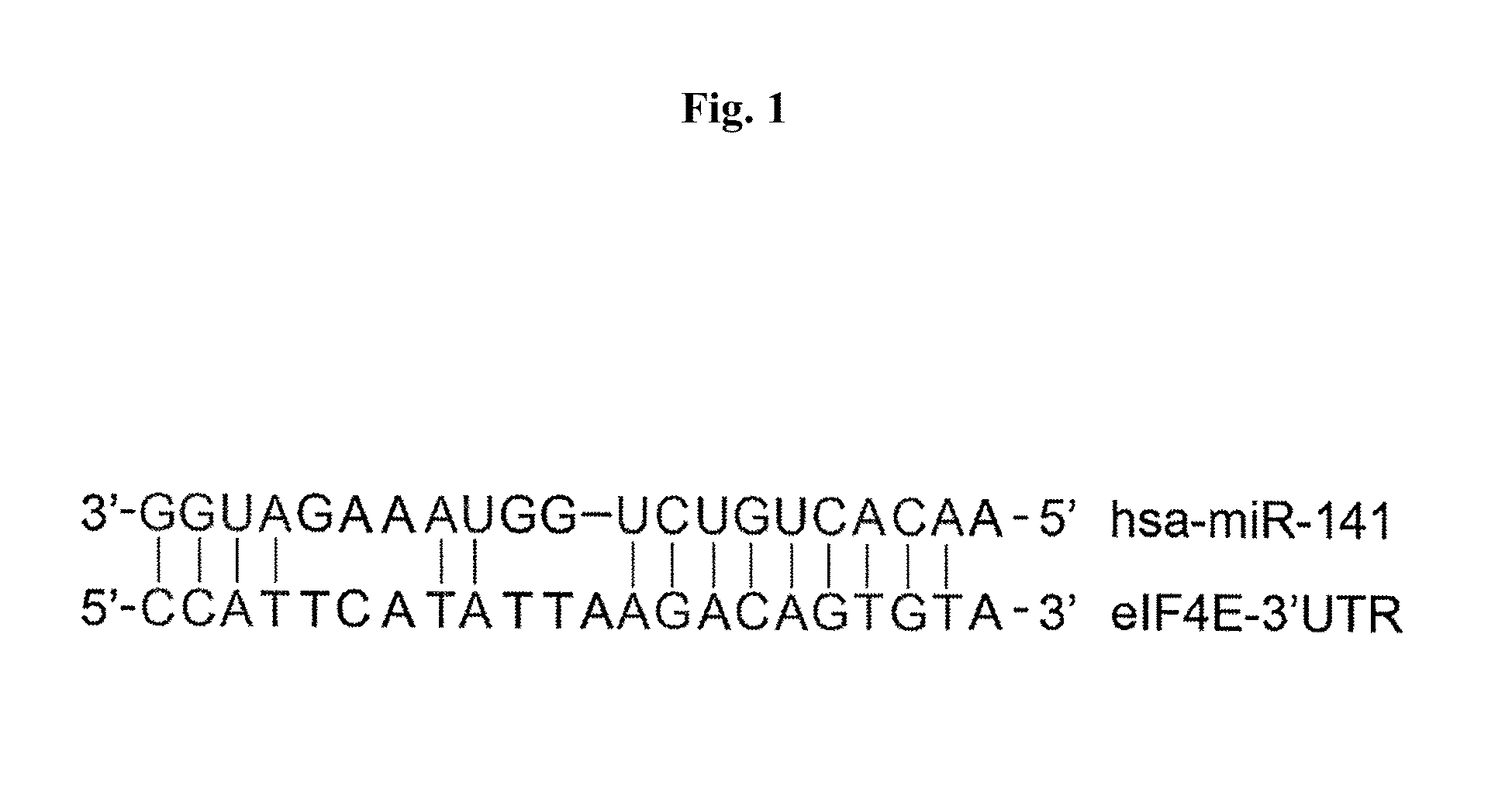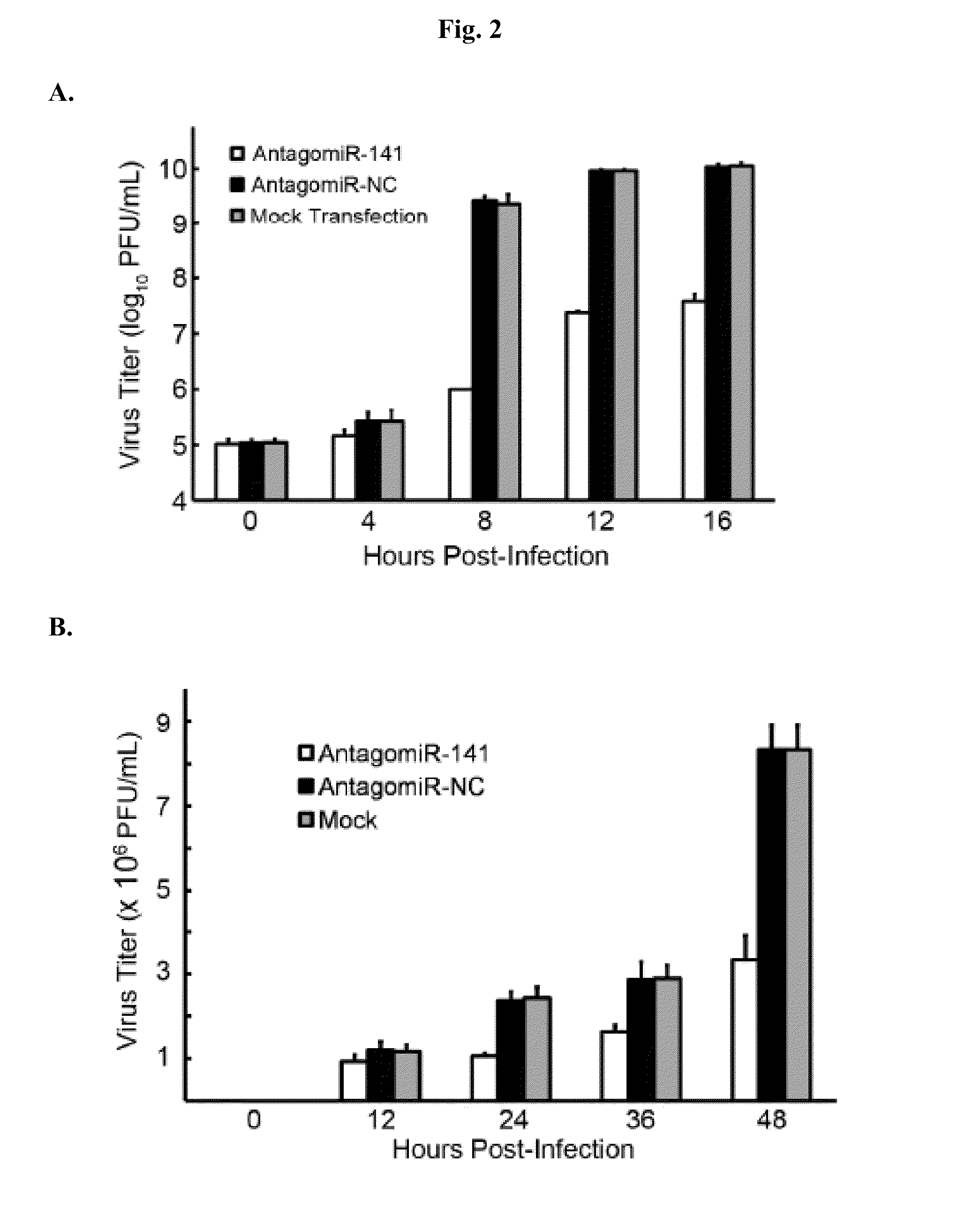Treating Picornavirus Infection by Targeting MicroRNA miR-141
a technology of mir-141 and picornavirus, which is applied in the field of treating picornavirus infection by targeting microrna mir-141, can solve the problems that no medications are currently available for treating picornavirus infections, and achieve the effects of reducing viral protein production, reducing mir-141 activity, and reducing eif-4
- Summary
- Abstract
- Description
- Claims
- Application Information
AI Technical Summary
Benefits of technology
Problems solved by technology
Method used
Image
Examples
example 1
Viral Infection-Induced miR-141 Overexpression Suppressed Cellular eIF-4E Expression
[0042]Human rhabdomyosarcoma (RD) cells were cultured in MEM medium supplemented with 1 mM L-glutamate, 100 units / mL penicillin, 100 μg / mL streptomycin, and 10% fetal bovine serum (Gibco). The cells were infected with poliovirus type 3 (PV3), coxsackievirus B3 (CVB3), or enterovirus 71 (EV71) in a serum-free medium and the cytopathic effect caused by viral infection was photographed under ZEISS Axiovert 200M (Zeiss) with 50× magnification. The captured photographs were analyzed using ImageXpressMICRO and MetaXpress image analysis software (MDS Analytical Technologies). Mock-infected cells were used as a control in this study.
[0043]After infection, the cells were harvested and RNAs were extracted from both viral-infected and mock-infected cells using the Trizol reagent (Invitrogen). Real-time PCR analysis was performed to determine the levels of miR-141 and eIF-4E mRNA in these cells by the TaqMan gen...
example 2
Inhibition of Viral Proliferation by AntagomiR-141
[0051]Human RD cells were cultured in MEM medium supplemented with 1 mM L-glutamate, 100 units / mL penicillin, 100 μg / mL streptomycin, and 10% fetal bovine serum (Gibco). These cells were transfected with antagomiR-141 (CCAUCUUUACCAGACA GUGUUA; SEQ ID NO:1), an RNA complementary to miR-141, or a negative control RNA by siPORT NeoFX transfection reagent (Ambion), following the manufacturer's instructions. The transfected RD cells, as well as mock-transfected RD cells, were infected with EV71 in a serum-free medium. The cytopathic effect induced by EV71 infection was photographed using ZEISS Axiovert 200M (Zeiss) with 50× magnification. The captured photographs were analyzed using ImageXpressMICRO and MetaXpress image analysis software (MDS Analytical Technologies). The built-in integrated morphometry analysis function of MetaXpress was used to quantify the cytopathic effect. Numeric data were analyzed using MS Excel (Microsoft). Result...
example 3
Inhibition of Viral Proliferation by Small Interfering RNAs Targeting EGR1
[0057]EGR1 was identified as a transcription factor regulating miR-141 expression. The levels of mRNA and protein of EGR1 were examined by real-time PCR and Westernblot, respectively, in RD cells infected with EV71. The results show that both mRNA and protein levels of EGR1 were increased up to 100 fold 4 and 8 hours after infection relative to those in mock-infected cells. This indicates that viral infection induces expression of EGR1 and consequently up-regulates miR-141.
[0058]Two potential EGR1 binding sites were identified in the 5′ regulatory region of the miR-141 gene. A chromatin immunopredipitation assay was performed, following the protocol provided by Updated Biotechnology, to examine whether EGR1 directly binds to the two putative binding sites. A DNA fragment encoding EGR1 with a V5 tag was inserted into pcDNA 3.1 and introduced into RD cells. 48 hours after transfection, the cells were treated wit...
PUM
| Property | Measurement | Unit |
|---|---|---|
| pH | aaaaa | aaaaa |
| dry weight | aaaaa | aaaaa |
| column chromatography | aaaaa | aaaaa |
Abstract
Description
Claims
Application Information
 Login to View More
Login to View More - R&D
- Intellectual Property
- Life Sciences
- Materials
- Tech Scout
- Unparalleled Data Quality
- Higher Quality Content
- 60% Fewer Hallucinations
Browse by: Latest US Patents, China's latest patents, Technical Efficacy Thesaurus, Application Domain, Technology Topic, Popular Technical Reports.
© 2025 PatSnap. All rights reserved.Legal|Privacy policy|Modern Slavery Act Transparency Statement|Sitemap|About US| Contact US: help@patsnap.com



